
MAY CONTAIN NUTS

Search Shorpy
SHORPY ART

Framed or unframed, desk size to sofa size, printed by us in Arizona and Alabama since 2007. Explore now.
Join and Share
Ad-Free Shorpy
Shorpy is funded by you. Patreon contributors get an ad-free experience.
Learn more.

Recent comments
- Party of Eight?
- Good choice
- Recent view
- Hudson’s Big Store
- Say what??
- Grapes?!
- Just a Great photograph.
- A Beautiful Moment
- Such joy
- Bethune-Cookman University today
- Yellow sky at morning
- Side Winder
- Air Quality?
- Sojourner Truth riot
- None were so blind(ed)
- The less famous sister
- Good ol' days?
- Rise and Fall
- Goo Goo Ga Joob
- Ticket Retention
- Not the only one
- Vagaries of War
- Killed by Amtrak
- Back to the Future
- Wanted --
- If you can't stand the light
- Centralized Traffic Control, I believe
- What's really happening
- Heckuva remote control!
- Sometimes — Things Go Bump!
Member Photos
The Shorpy
Print Emporium
Print Emporium
Search Shorpy
Search results -- 30 results per page
- Michigan Mystery #1
- ... a camping trip from the watertown area of Wisconsin into Michigan through Michigan's Upper Peninsula. I'm trying to figure out where these were taken, ... Posted by mamyers - 08/24/2012 - 9:46pm -
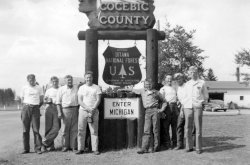
- Michigan Manselet: 1910
- Circa 1910. "Morgan residence -- St. Clair Flats, Michigan." 8x10 inch dry plate glass negative, Detroit Publishing Company. ... Posted by Dave - 10/02/2016 - 4:06pm -
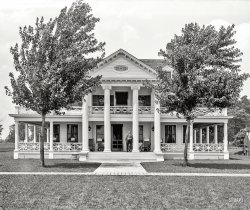
- Ferndale, Michigan: 1928
- Nine Mile Road just west of Detroit's main thoroughfare, Woodward Avenue. Ferndale became a boomtown in the 1920s when Henry Ford created the $5 workday wage. His factory was located a few miles south on Woodward in Highland Park.
Ferndale was ... Posted by kbreenbo - 09/19/2011 - 9:17pm -
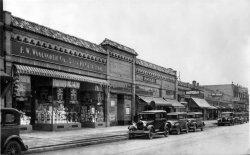
- Michigan Plungers: 1910
- Circa 1910. "Afternoon plunge, Saint Clair Flats, Michigan." 8x10 inch dry plate glass negative, Detroit Publishing Company. ... Posted by Dave - 01/21/2018 - 5:51pm -
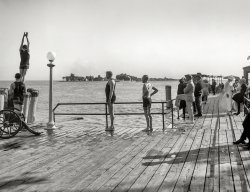
- Michigan Sugar: 1908
- 1908. "Michigan Sugar Co., Saginaw." Processor of sugar beets. 8x10 inch dry plate ... Posted by Dave - 03/31/2015 - 6:29pm -
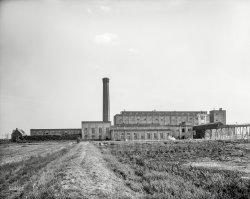
- Flint, Michigan: 1929
- Flint, Michigan 1929. My mother was 7 years old at the time. She is sitting in the ... Posted by Jking - 03/01/2010 - 10:27am -
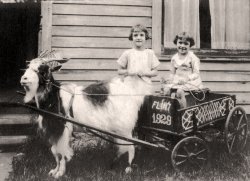
- The Pontch Again: 1912
- Detroit, Michigan, circa 1912. "Hotel Pontchartrain." Yet another view of this ... Posted by Dave - 11/08/2023 - 5:20pm -
![The Pontch Again: 1912 Detroit, Michigan, circa 1912. "Hotel Pontchartrain." Yet another view of this relatively short-lived hostelry on Woodward Avenue, whose downfall was a paucity of private bathrooms. Familiar landmarks include the Soldiers' and Sailors' Monument, Cadillac Square and the Cadillac Chair. 8x10 inch glass negative, Detroit Publishing Company. View full size.
"Misfit"I wonder what went down at "MISFIT"? Or did they just sell irregular clothing? And what could those fellas on the corner be taking a gander at?
[Misfit was the haberdashery owned by Sol Berman at 120 Woodward Avenue. The headline below is like something out of the Onion. - Dave]
Anywhere you wantThere do not seem to be much in the way of parking regulations yet. Check out the street in front of the hotel.
Nice Cleanup DaveI downloaded the original image from the LOC a while back. You've done a very nice cleanup job for the Shorpy site! Thank you.
[Thanks, but I didn't do any "cleaning up." - Dave]
My mistake. I'm confusing this image with a sister image you've previously posted that was pretty distressed.
Cheep lodgingsHenry Ford had a purple martin bird house at his home Fairlane that he called the Hotel Pontchartrain. Don't know if Albert Kahn was the architect.
You'd Almost ThinkApparently, the plethora of windows was no offset for the paucity of bathrooms.
Street sightingOdd load waiting to cross the street. Coil of rope? Life preserver? Spare tire?
Aha! Much clearer in closeup. The fellow is obviously hefting a coil of rope headed for a nearby ship chandlery.
(The Gallery, Detroit Photos, DPC, Streetcars)](https://www.shorpy.com/files/images/4a19783a.thumbnail.jpg)
- Michigan Swimming Hole: c. 1920s
- ... this photo on to me. It is almost certainly taken in the Michigan lower peninsula. I'm still researching who the people are and I guess ... Posted by Karlheck - 06/28/2011 - 11:12am -
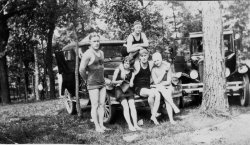
- Coldwater, Michigan: c. 1865-75
- ... I found Tibbit was a very important citizen in Coldwater, Michigan, who built Tibbit's Opera House in 1882, which is still open today ... Posted by stuwil - 09/16/2011 - 2:02pm -
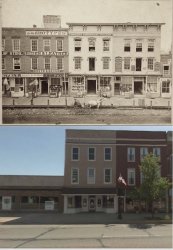
- Alma Sugar: 1901
- Alma, Michigan, circa 1901. "Alma Sugar Co. factory." An early manifestation of the ... Beets" https://youtu.be/KuZNSGdg2ms
Sugar from Michigan? I never heard of Michigan sugar, so I looked it up (of course!).
... Posted by Dave - 10/15/2021 - 12:26pm -
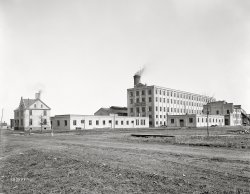
- Michigan Bluff Posse: 1905
- ... 1905 Posse organized to find and arrest a murderer near Michigan Bluff in Placer County, California. Left to right: Coroner W.A. ... Posted by rgibsonx2 - 04/10/2015 - 7:12pm -
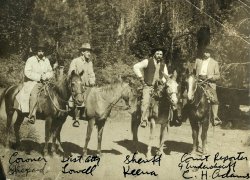
- Willow Run: 1942
- ... plant, the giant Ford bomber factory at Willow Run, Michigan. Fixtures in background hold bomber wings during assembly." Photograph ... being assembled here at that time?
Thunder Over Michigan Good timing, as the Yankee Air Museum at Willow Run was hosting ... Posted by Dave - 07/30/2012 - 10:52am -
![Willow Run: 1942 July 1942. "Willow Run bomber plant. A small part of the world's largest one- story war production plant, the giant Ford bomber factory at Willow Run, Michigan. Fixtures in background hold bomber wings during assembly." Photograph by Ann Rosener for the Office of War Information. View full size.
YpsiI love seeing the plant on Shorpy! I went to Willow Run School District for all K-12. The district, and practically all of Ypsilanti Township, was built for the families that came up (mostly from the South) to work at the plant. I loved hearing the stories. There's a great museum at Willow Run Airport.
Go Flyers! Class of 2001!
Willow RunI grew up in Belleville in the 60's, less than a mile from the plant, and have always had a fascination for its history. My grandfather worked there during the war as a machinist (center section) and always had some interesting stories. I actually worked at Willow Run in the 70's and 80's, and at one point worked in Hangar 1, Bay 4, the subject of another Shorpy picture. Unfortunately the B-24's were long gone. My dad tells of seeing them lined up along the Ecorse Road side of the field after the war, scheduled for demolition, lined up three rows deep for nearly a mile.
Willow Run IICharlie Paterson, a manager of Willow Run, was later a company vice president. I had to report to him because one my workers had cut off his thumb while operating a stamping press. Years later as I was walking back from lunch we met, he remembered me, he asked how I was doing etc. etc. as six or seven of his assistants stood waiting wondering how a vice president knew a die room supervisor.
Willow Run IIIIf memory serves me correctly, Ford made Consolidated B-24 bombers at this plant, or at least the airframes for them. Were there any other warplanes being assembled here at that time?
Thunder Over MichiganGood timing, as the Yankee Air Museum at Willow Run was hosting the 10th annual Thunder Over Michigan air show the day this image was posted. A lot of great old warbirds on display and flying, including a couple B-24s. This show just gets better every year.
Willow Run JigsBeing an engineer and lifelong aviation enthusiast, I always love the photos of the aircraft factories. I am curious as to what the jigs in the foreground are for, as I can't quite make out the shape of what's being put in them. Any guesses? Control surface structure? Perhaps Dave can provide a closer look at the racks or one of the nearly completed jigs near the bottom of the photo?
[Click below to enlarge. Depending on your browser you may need to click a second time to expand the image. - Dave]
JigsI'm thinking that it's the wing in-spar rib assembly area, though it's kinda hard to tell since there isn't a completed one on the tables. Looks like they just do the forming of the outer ribs and maybe it goes to another area (off camera) for the attachment of the flat sheet metal to complete the rib. The proximity to the wing jig makes me think my guess might be correct. That and I work in a rather large plant (Boeing 747) right now.
Willow Run PhotoI believe they are assembling wing spars for North American B-25 "Mitchell" bombers. I can do some digging on the web for confirmation, if necessary, but I remember reading recently that they were assembled there early in the war, before B-24 production ramped up. Note that the spars are not straight; the B-25 had a strange inverted gull wing.
New to this site: FABULOUS!
Willow RunWow, thanks so much for sharing this photo. My grandma worked at this plant during the war; for all I know, she could be one of the ladies in the foreground. She carpooled with coworkers every day from River Rouge. I'm going to have a copy of this printed and share it with her. Thanks again!
Willow RunTom
I also grew up in Belleville, and graduated BHS in 1956. I worked for Capital Airlines in 56, loading baggage out of the final assembly building, which was then the terminal. I also learned to fly at WCFS at RML.
As a small boy I lived near City Airport, and recall stories of them flying completed B-24's full of gas into City, draining the tanks, and shipping them out on flatcars as spare parts. The gas went down the sewers, they say, or into local's car gas tanks, if cars could be set up to run on 100 octane.
Drove by City Airport last summer. Really sad.
Brian
Luscombe Driver
Willow Run workbenchesMy grandfather worked at Willow Run during the war and acquired one of the work benches shown here. The legs look like they are made out of angle iron but were in fact one piece cast iron. I still have the leg sections and will try to reproduce the top. Thanks for the great pictures.
Willow RunHi Tom. Is your dad still alive? I grew up in Willow Run in the 50s/60s, my grandfather had a drycleaning company that picked up and delivered in the village. I've never heard the story about the planes. I'll have to ask my dad if he remembers that. Where do you live now, by the way?
B-24 stringersThe channel-like material in the foreground might be "stringers" for the wing surfaces. These ran spanwise just under the skin and gave strength to the structure. An example can be seen at this B-24 wreck on Humphrey's Peak in Arizona.
To BrianI also lived near City airport We moved into our brand new house in February,1950. I was six years old. Shortly after we moved in, a large cargo plane crashd just a few blocks away, destroying two homes, I will neveer forget walking over there to see it. My mom got nervous everytime she heard a plane going over after that.
Worked near this areaI graduated from Chelsea High in June l942, worked at the bomber plant July 1942 until Feb 1943 when I went in the Army Air Corps. I worked near this section alongside of the noisy center wing section mounting castings for the landing gear.
In the early days things were slow getting up production. If the production line didn't move to take out a center wing we were idle until they moved one, they would have us sort rivets to make us look busy, when we got them sorted we would mix them up and we would sort them again. I tell people that production sped up after I left. In November 1943 after I graduated from airplane mechanic school I was sent to Pratt & Whitney engine school on the other side of Willow run airport.
Re: Willow RunI always look for my mother in Willow Run photos. She left Kentucky to work in that plant.
(The Gallery, Ann Rosener, Aviation, Factories, WW2)](https://www.shorpy.com/files/images/8e11142u.thumbnail.jpg)
- B-29 City of Michigan: 1944
- WW2 B-29 bomber with flight crew taken at Walker AFF in Kansas in 1944 during training before leaving to Guam to join the 459th Bombardment Squadron. The 459th BS was part of the 330th Bomber Group which was part of the 314th Bombardment Wing. Thi ... Posted by AmerHistory - 10/16/2015 - 6:23pm -
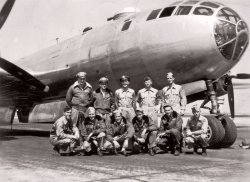
- S.S. Deathtrap: 1910
- ... Electric employees, families and friends across Lake Michigan to Michigan City, Indiana, for a day of fun and fellowship. But the festivities ... Posted by Dave - 09/24/2023 - 9:40pm -
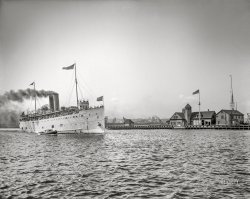
- Swedish Softball: 1942
- September 1942. "Cass Lake, near Pontiac, Michigan. The Westerberg family outside the home which Karl Axel Westerberg, a ... Posted by Dave - 10/12/2023 - 5:07pm -
![Swedish Softball: 1942 September 1942. "Cass Lake, near Pontiac, Michigan. The Westerberg family outside the home which Karl Axel Westerberg, a Swedish immigrant who is a foreman at the Dearborn plant of Ford Motor Company, and his son, Eric, built themselves after working hours. Eric, his young son Karl, his father and mother, and Mrs. Eric Westerberg in the backyard of their house. It is a modern well-designed home with all conveniences, including an electric refrigerator and stove." Photo by Arthur Rothstein for the U.S. Foreign Information Service. View full size.
I can't find the houseThe Westerberg family (L-R) are: Eric 36, Carl 5, Carl 59, Elda 57, and Anna 36. In the 1950 Census, below, both Carls are spelled with a C. The two generations live next door to each other at 4740 and 4750 Centre, still near Cass Lake (West Bloomfield, Oakland County). But I cannot find their street, or the addresses on the next street, 1859, 1843 and 1650 Oakland, today.
Carl Sr., Elda, and Eric were all born in Sweden. Seems they lived the American Dream.
Click to embiggen:
That low September sunI hope young Karl manages to see the ball before it hits him; it looks like it's coming toward him more than grampa. He's got the sun right in his eyes, an outfielder's nightmare.
4740 Algonquin Ave, West Bloomfield.Tough one to track down!! At some point, Centre (also spelled Center) became Algonquin Ave. Oakland Ave became "Oldtown Ave". Using that data, you can find both houses mentioned by Doug Floor Plan. Both houses show built in 1940. No Google street view though.
Possible matchI couldn't let this go so, eventually, I found two houses that were next to each other with the right house numbers, 4740 and 4750, but they were on Algonquin Rd. Both were built around 1940, which is in line with the photo, and 4750 seems to match the photo. Unfortunately, there's no google street view because they are in a private subdivision called Zox Cass Lakeside (!?!), established in the 1920s. I eventually found a map from 1930 that shows that Algonquin Street's original name was Center. Eureka!
[Dear people: Please do not submit the same damn comment ten times. Thank you! - The Management]
Sorry, the software gave me an error ("Spam_flag_status_1"), so I assumed it wasn't accepted. I'll assume it's accepted if I see that again.
(The Gallery, Arthur Rothstein, Kids)](https://www.shorpy.com/files/images/SHORPY-8d07978a.thumbnail.jpg)
- The Library: 1901
- "University of Michigan library reading room, Ann Arbor, 1901." Detroit Publishing Company ... represent, and what does the subject have to do with Michigan? Go Blue!!!
Steam Heat What a unique shape for the radiator ... up very well against a century ago.
Heroic Figure of Michigan The sad end of the plaster statue of Michigan is described here ... Posted by Dave - 07/26/2012 - 12:31pm -
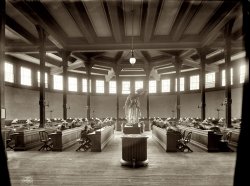
- City Hall: 1907
- Lansing, Michigan, circa 1907. "City Hall." Where the time is I:XLIII, or XVII minutes ... Spent its life - most of it anyway - in the shadow of the Michigan State Capitol (certainly figuratively and in the evening pehaps ... the MICHOP corner.
Click to embiggen.
Michigan Capitol construction They are currently installing geothermal heat ... Posted by Dave - 08/02/2022 - 12:45pm -
![City Hall: 1907 Lansing, Michigan, circa 1907. "City Hall." Where the time is I:XLIII, or XVII minutes to II. 8x10 inch dry plate glass negative, Detroit Publishing Company. View full size.
MCMLVIII: requiescat in paceSpent its life - most of it anyway - in the shadow of the Michigan State Capitol (certainly figuratively and in the evening pehaps literally). Silver Medalist in the Most Impressive Building in Town contest is apparently no guarantee of survival.
Unknown growthThe clock is interesting but what is that growth on the building to the left? Intentional? Accidental?
[That's ivy, and it's horticultural. - Dave]
Distracted informationI went to get a Google Earth view of the Lansing City Hall today and am including additional information that distracted me. The city hall is labeled in the upper right. It's much larger than was needed in 1907, plus it's all new and shiny. Then I got distracted by the construction on the capitol grounds. Looks like something is being built underground. But the front lawn is pristine green. Then I noticed there are five churches on the block just north of the capitol. The four labeled are Methodist, Christ Community, Catholic, and MICHOP. The one not labeled is Episcopal. Where I grew up a big Baptist church would occupy the MICHOP corner.
Click to embiggen.
Michigan Capitol constructionThey are currently installing geothermal heat to the Capitol, and building a museum/visitor center. The construction has been ongoing for a couple years, slowed by Covid, but fingers crossed it will be complete in about a year.
https://www.lansingstatejournal.com/story/news/2021/04/12/update-geother...
(The Gallery, Bicycles, DPC)](https://www.shorpy.com/files/images/SHORPY-4a18687a.thumbnail.jpg)
- Arthur Zickgraf: 1913
- ... Zickgraf (standing far right) with his surveying class at Michigan Agricultural College in 1913 - Now Michigan State College. He later became a civil engineer and started Wolverine ... Posted by ltitus - 04/26/2007 - 9:29pm -
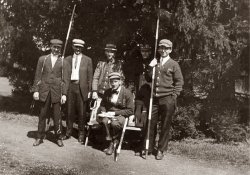
- Miller Time: 1942
- September 1942. "Detroit, Michigan. Milling machine operator at the Allison Motors plant." Acetate ... Posted by Dave - 10/15/2023 - 5:06pm -
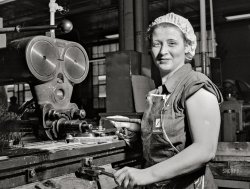
- Let's Get Fiscal: 1942
- September 1942. "Detroit, Michigan. Office worker at aircraft engine plant, Allison Division of General ... Division, General Motors" with a reference to "Detroit, Michigan." But (aside from Rothstein's photos) I can find no evidence that such ... Posted by Dave - 10/13/2023 - 11:52am -
![Let's Get Fiscal: 1942 September 1942. "Detroit, Michigan. Office worker at aircraft engine plant, Allison Division of General Motors." Photo by Arthur Rothstein for the Office of War Information. View full size.
FridenThat is a Friden calculator. It adds, subtracts, multiplies and divides, all mechanically. The electricity just runs a motor that turns the gears. No floating point decimal though, so you have to know where it goes. Some versions of this calculator will extract square roots.
The good old Friden calculatorIn the 60's, my mother worked as a lab assistant at an agricultural experiment station, and the PhD she worked for had one of those beasts. I often visited the lab and one day after doing simple additions and subtractions on it, a decided to do a division problem. Big mistake. The machine went into gyrations while sounding like it was stripping gears. The good doctor poked his head out of his office and gave me the filthiest of looks. Later on, my mother would borrow it and haul it home so I could use it to do her taxes.
Detroit - or Indy?The Library of Congress's archives include dozens of Arthur Rothstein pictures of individual workers at an "aircraft engine plant, Allison Division, General Motors" with a reference to "Detroit, Michigan." But (aside from Rothstein's photos) I can find no evidence that such a plant was in Detroit. During WWII the Allison Division of General Motors operated large aircraft engine plants at Speedway, Indiana and nearby Indianapolis, and of course other GM divisions had plants in and around Detroit - but perhaps not the Allison Division. https://usautoindustryworldwartwo.com/General%20Motors/allison.htm
[The Cadillac plant in Detroit manufactured parts for GM's Allison Division. - Dave]
Divide by ZeroMy father used a large 9 column mechanical calculator to balance the books at our small dime store. I used to play with at times. When you tried to divide by zero it would go through some amazing mechanical spasms before it would spit out a "0.0".
Musical NumbersEverything you need to know about the Friden calculator is in this video. There is a scene with Jack Lemmon in the movie "The Apartment" working on a Friden calculator. He enters a sequence of numbers to produce the "Friden March."
(The Gallery, Arthur Rothstein, Detroit Photos, The Office)](https://www.shorpy.com/files/images/SHORPY-8d08002a.thumbnail.jpg)
- Tailgate Gourmet: 1960
- ... their Dodge Lancer." View full size.
University of Michigan Based on the Maize (yellow) and Blue scoreboard!
UMich Sure looks like Michigan Stadium in Ann Arbor to me.
The Great Pumpkin Apparently he ... Posted by Dave - 11/14/2013 - 11:58am -
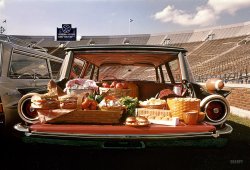
- Dept. of Public Works: 1900
- Ypsilanti, Michigan, circa 1900. "Water tower." 8x10 inch dry plate glass negative, ...
Oh, yeah It's still there. I attended Eastern Michigan University, which is right across the street, in the early '90s. Even ... few years ago. I miss it so much! Thank you! More pics of Michigan Normal School Please!
Suddenly I feel so inadequate.
Ypsi! ... Posted by Dave - 08/13/2012 - 9:13pm -
![Dept. of Public Works: 1900 Ypsilanti, Michigan, circa 1900. "Water tower." 8x10 inch dry plate glass negative, Detroit Publishing Company. View full size.
StunningNo mature adult can ignore the stunning Freudian symbolism.
It lives!I can firm that the Ypsilanti Water Tower still thrusts skyward. It even won a "Most Phallic Building" award in 2003.
View Larger Map
Sometimes a water tower ...Yeah ... so that's uhh ... hmmmm ... yeah.
The Consequence of RepressionIt's Phallic Symbolism Day on Shorpy and I'm lovin' it! You don't have to be a shrink to see that the designer of this innovative structure had some unresolved and repressed "issues". Thank goodness that such repression was more prevalent then, when buildings were built to last for generations, as opposed to today when buildings aren't intended to last at all. I hope this manly tower still stands. Does anyone know?
YpsituckyWhen I was at university at Ann Arbor, Ypsilanti was called "Ypsitucky" in reference to all the Kentucky immigrants who landed there.
Kalamazoo had a similar water tower. The legend was that it would collapse when the first virgin was graduated from WMU.
The lady on the left is... spellbound.
Oh, yeahIt's still there. I attended Eastern Michigan University, which is right across the street, in the early '90s. Even though I now live just east of Jackson, I occasionally drive past this giggler to get from Ann Arbor to Ypsilanti via Washtenaw Avenue.
By the way, I've been enjoying this site for over a year. This is my first post.
[Welcome to the Hotel California! - Dave]
Is that a water towerin your town, or are you glad to see me?
Yay!I grew up in Ypsi and lived behind the "brick ***k" when I was in school a few years ago. I miss it so much! Thank you! More pics of Michigan Normal School Please!
SuddenlyI feel so inadequate.
Ypsi!It's barely changed in 110 years! I had a good view of it from my ninth-floor dorm across EMU's campus a couple years back -- at Christmas they always put a little lighted star on the tip.
Eastern Michigan UniversityBy the way, that's Eastern Michigan University on the right. The building is where the current Student Union is.
Continue West on this road for about, I dunno... about a mile, and you come to Ann Arbor, the home of the University of Michigan.
The tower today is missing that snazzy little cupola on top, although the base still remains. Sort of looks like a lighthouse or beacon of some kind.
Ypsilanti was also the home of the Tucker automobile company, but I think this landmark may be our greatest claim to fame!
Welch HallActually, that's Welch Hall to the right, not the McKinney (Student) Union, which would have been directly behind the water tower except that it wasn't built until about 20 years later.
(The Gallery, DPC, Industry & Public Works)](https://www.shorpy.com/files/images/4a09010a.thumbnail.jpg)
- The Automobilist: 1910
- ... be a 1906 - 1908 Pungs-Finch (P-F) car made in Detroit, Michigan from 1904 - 1910. What first led me to this conclusion was the script ... Posted by Dave - 09/11/2023 - 3:03pm -
![The Automobilist: 1910 Detroit circa 1910. "Automobile on town street." More specifically, Jefferson Avenue at East Grand Boulevard. The building at right is Moesta's Tavern at 1407 Jefferson (also seen here). 8x10 inch glass negative, Detroit Publishing Company. View full size.
Ellie IncognitoI think this is Elinor Blevins in disguise. How many paople would own a pair of gloves like that?
Eat my dust...I've got a horseless carriage and you guys DON'T!
A pair of gloves like that?Put me down as one owner; got them about 35 years ago, kept the leather (hand) part nearly soaked in mink oil. The long fur sleeves are wonderful, used them today with the temps in the teens. Snowmobile used to call them "snot-wipers," the furry part being perfectly located for that work.
WindowsWhat are the words in the window of the building to the far right?
[Too blurry to tell. - Dave]
WHAT is the world coming to?Danged hot-rodders!
Seriously, can anyone make out the model of the car?
This looks to have been in an upper-class neighborhood. Look at the size of the houses and how clean everything was. Also, no packs of "feral children" are running wild in the streets!
Moesta's Store?The illegible shopfront sign got me curious, so I rummaged around in the LOC's Detroit Publishing Co. images that included automobiles. There are two more views of this street scene in the collection, taken at slightly different times, but each with a passing car. The LOC cataloger devised the titles from scrutiny of the original 5x7 glass negatives, listing one as "Street with automobile and Moesta's store," (LC-D418-31165) and the other as "Street with Moesta's store and Fuller Savings Bank" (LC-D418-31166). I'm not sure that the reading of "Store" is quite right, since the S-word looks longer than that in the image posted here, but the "Moesta" seems correct. There don't seem to be any other online references to these businesses, but a Moesta family genealogy page (a German surname later anglicized to Mesta) suggests Pittsburgh, PA as a possible locale for the period of the photo.
Wealth creationThe home on the left is a great house. Even when wages were only a dollar a day, there have been people that could do things that would make them rich. I think that is wonderful.
You big dummy...The driver of that car sure looks a lot like Fred G. Sanford to me...the G is for gasoline.
Early BuickMy guess on the make of automobile is A Buick Model 10 (produced from 1908 - 1911). This appears to be a runabout version without the back seat. Very sporty, no matter what.
DetroitJefferson Avenue and East Grand Boulevard. Shown below circa 1936.
Pungs-Finch?The auto looks like it might be a 1906 - 1908 Pungs-Finch (P-F) car made in Detroit, Michigan from 1904 - 1910. What first led me to this conclusion was the script lettering on the radiator - which although blurred seems to be two words. The script is certainly is not the word "Buick," but there are many similarities between the two marques.
Other identifying features in common with a P-F are the radiator shape and single strap running across the hood; tie bar below the front chassis; front axle almost directly below the radiator; rounded cowl shape and lights only on the cowl as seen in all early P-F advertising; fender line; tank or muffler below the left side chassis; and the curved body line from the top of the cowl to the front of the seat.
I am not 100% sure it is a P-F because I have not found any other photos with this exact script on the radiator or the horizontal lines running across the radiator. Everything else seems to match perfectly.
The Pungs-Fitch was made by a father and his son-in-law (W.A. Pungs and E.B. Finch). Pungs supplied the money and Finch supplied the engineering ability. They bought out the Sintz Gas Engine Company and claimed Sintz' history as their own. It is estimated that only a few hundred cars were made during their seven years in production and only two cars appear to survive.
The cars shown below are from the January 1, 1909 Cycle and Automobile Trade Journal. The fenders have been modernized, but otherwise looks nearly identical to the earlier models. Note that the Runabout and Touring Models used different hoods.
Moesta's Saloon in DetroitI found the following information online, but there was no date attached to the newspaper article nor the newspaper name.
"Detroit's most famous east side saloon, on Jefferson avenue at East Grand Boulevard since 1875, is being torn down. Formerly the headquarters of Detroit River yachtsmen, it was operated by Henry Moesta until prohibition drove him from business. His father, Henry Moesta the first, founded the tavern." Henry (the first) ran the business for about 17 years, and Henry (the second) continued on for another 23 years - roughly 1879 - 1919.
"I would have grown rich, like so many others," said Henry Moesta the second. "I preferred to obey the law like my father before me and keep always the memory of the honest place he constructed."
"The Moesta place was taken over by Harry Gordon when prohibition arrived."
"Henry Moesta's brother, Charles was also a famous tavern-keeper until prohibition arrived, when he too abandoned the business."
The story also states, "Now they are tearing the tavern down to make way for a bridge boulevard and the marine atmosphere that attached the vicinity of Jefferson avenue and East Grand Boulevard with the fresh flavor of the inland seas will never be the same again."
The street address was 1407 Jefferson Avenue which was directly across the street from the Detroit River. In the Detroit phone directory the business was described as a "Restaurant and Cafe, Imported and Domestic Wines, Liquors, and Cigars."
The photos below show the sign in front of Moesta's Saloon and a photo of part of the newspaper article showing Henry Moesta (the second) and his brother Charles Moesta along with two views of the business.
Note: This main portion of the article was very out of focus and I tried to copy everything correctly, but some words may not be correct in my quotes because reading portions of the text was so difficult.
Amazingly, there is actually a photo of the inside of the Moesta Saloon here.
(The Gallery, Cars, Trucks, Buses, Detroit Photos, DPC)](https://www.shorpy.com/files/images/SHORPY-4a18077a.thumbnail.jpg)
- Uncle Joe: 1922
- ... Joe" Cannon, congressman from Illinois, accessorized with Michigan lawmaker Vincent Brennan and a big cigar. National Photo Co. glass ... on the front of its very first issue, in 1923.
Michigan not Maine Vincent Brennan was a congressperson from Michigan, not ... Posted by Dave - 09/04/2012 - 11:08pm -
![Uncle Joe: 1922 May 8, 1922. "Cannon & Brennan at Capitol." Former House speaker "Uncle Joe" Cannon, congressman from Illinois, accessorized with Michigan lawmaker Vincent Brennan and a big cigar. National Photo Co. glass negative. View full size.
The Wit and Wisdom of Uncle JoeAlso known as "foul-mouth Joe".
"I am g**damned tired of listening to all this babble for reform. America is a hell of a success."
"Not one cent for scenery."
"Teddy Roosevelt has no more use for the Constitution than a tomcat has for a marriage license."
"I am one of the great army of mediocrity which constitutes the majority."
Yikes ... now that's a "stick"Cigar smokers sometimes refer to a cigar as a "stick." In this case that "stick" is more like a branch! That said, I've seen pictures of the hand-rollers in Cuba with similar "big smokes." Apparently, they are allowed to smoke "one cigar a day" and roll themselves something large and long, a sort of "all day smoker."
Bang!I wonder if anybody ever slipped him an exploding cigar. Need a light?
Who rolled that cigar?Personally I'd put my money on Cheech and Chong.
Uncle Joe SaysTheodore Roosevelt "has no more use for the Constitution than a tomcat has for a marriage license."
Cannon retired from the House in 1923. He was first elected to the House from Illinois in 1872. He had served, with a couple of interruptions, 'til March, 1922. He had been Speaker from 1903 to 1911.
Joe was so old in 1922 that his personal history included support for Abraham Lincoln for president in 1860. Little wonder Brennan looks a little awed.
Joe died in his bed at age 90. Don't make 'em like that any more. Nor them cigars, neither.
[He's also namesake of the Cannon House Office Building. - Dave]
Big cigar indeedWhere's Freud when you need him?
Proper attireIn 53 years, standards of senators' dress fell off a cliff.
Cigar and AttitudeA big cigar and attitude to match.
Speaker CannonTR had a small brass cannon at Sagamore Hill, his house in Oyster Bay, which he would fire off every day to entertain his children. Roosevelt named the artillery piece "Cannon Speaker." I am sure that there were a number of other quips that he made when putting the piece to work.
The beginning of TimeUncle Joe was Time magazine's inaugural cover boy -- he appeared on the front of its very first issue, in 1923.
Michigan not MaineVincent Brennan was a congressperson from Michigan, not Maine. But both states do start with M.
[Wups. Thankew! - Dave]
Later known as ...Senator Byrd.
Tired of Byrd BashingSen. Byrd seems a frequent target of comparison of any elderly politician pictured on Shorpy. While I cannot defend every position the honorable senator has taken, he has done well both for the interests of his state and for upholding the constitution and tradition of the Senate.
The following is a snapshot of me as a child on a visit to the Senator's office in July 1975.
[A nice photo. But -- although that comment was digit-related, the digit has nothing to do with age. - Dave]
Oh ME, Oh MICongressman Brennan represented Michigan rather than Maine. This was probably about as close as he came to meaningful power during his two-year tenure in Congress.
Modern PharmacologyThis looks like it could be a pharmaceutical ad for an anti-aging drug.
Formidable StogieWhen "Uncle Joe" said he was going outside for a smoke, his colleagues knew they wouldn't see him again for a couple of days.
FreudianIn this case a cigar is only a torpedo.
Uncle Rip and Uncle JoeHarold Austin Ripley, my mother's sister's husband, was one of Joe Cannon's page boys. I recall some of his stories about Uncle Joe -- not the least of which involved running to a nearby cigar store to restock the Speaker's humidor. You might imagine my total surprise, then, on coming upon this photo of Cannon, cigar in hand. What a flashback trigger!
Rip tried to enlist when the U.S. signed on to the war, but his parents (Rip's father worked for the U.S. Mint) wouldn't sign off -- Rip was 16 in 1917. So Rip asked his boss to write a letter of recommendation on his behalf, making up some story about why he needed it. I cannot recall the exact wording, but it began: "I highly recommend Master Ripley etc etc." Rip took the letter to a D.C. recruiting station. The master sergeant in charge took one look at the letterhead and the signature at the bottom -- and sat up ramrod-straight in his chair, as Rip liked to tell it. No questions asked. The next thing my uncle knew, he was on a troopship bound for Europe.
The army discovered his real age in France and assigned him to the Graves Registration Dept, out of harm's way. Rip and his buddies stayed drunk on cheap French vin; there was no other means of confronting the awful stench of no-man's land. Gas masks, he said, proved worthless.
Master Ripley returned to the U.S. a devoted though albeit functional alcoholic, and remained so until 1940 when he imbibed his last distilled spirits (from Crown Royal to Royal Crown cola -- Rip has cases of the latter in his basement). He became, in the following order during those intervening years: the first territorial salesman for LifeSavers; crime reporter for The Chicago Tribune; the author of Minute Mysteries (read in a minute/solve in a minute) syndicated in over 150 daily newspapers; the longest continuous columnist (Photo Crime, 13 years) in Look magazine; and finally the founder of Guest House, a retreat for alcoholic priests located in the grandiose Scripps estate at Lake Orion, MI, and which recently celebrated its first half-century of drying out Catholic clergy from all over the world. The Catholic hierarchy -- totally befuddled -- simply ignored and abandoned their alcoholic priests, so Rip stepped in and devoted the rest of his life to their rehabilitation and recovery.
For all his imagination, crime-plotting ability and investigative skills, Austin Ripley could never have imagined the greater crime now tearing apart Catholic dioceses around the world. I'm glad he never lived to see it.
What do your cats look like?Fancy meeting you here!
Uncle Joe really was my Uncle...my Great-Grand-Uncle.
My Great-Grand-Mother was Joseph Gurney Cannon's Sister.
Maybe our Grand Mother's traded cats too!
Cheers Cousin!
(The Gallery, D.C., Natl Photo, Politics)](https://www.shorpy.com/files/images/22931u.thumbnail.jpg)
- Size Matters: 1942
- September 1942. "Detroit, Michigan. Learner at the Allison Motors plant. Dimensional finishing." Photo by ... Posted by Dave - 10/14/2023 - 11:17am -
![Size Matters: 1942 September 1942. "Detroit, Michigan. Learner at the Allison Motors plant. Dimensional finishing." Photo by Arthur Rothstein for the Office of War Information. View full size.
The work of an Old MasterThe last two Rothstein pictures remind me of what a fine craft photography used to be. He's doing a routine assignment for the War Dept and turns out a couple masterpieces.
[This (and the other photo) are among seven from this assignment marked "Killed," meaning they were found for whatever reason to be unsuitable for publication. Credit for how they look here goes in part to Photoshop. (And me?!) Below, an image contrasting the edited photo with the original unprocessed scan. - Dave]
Learner needs to learnHow to wear a particle mask. At least when there is a photographer around.
[If he's not grinding, he doesn't need the visor or the mask. Using a micrometer doesn't require any protective gear. - Dave]
That shirtIt is obviously a work shirt and will not be worn to church on Sunday or anywhere dressy. Still, it is ironed and there is a crisp crease going down the sleeve. 1942 was indeed a different age than today.
(The Gallery, Arthur Rothstein, Detroit Photos, Factories, WW2)](https://www.shorpy.com/files/images/SHORPY-8d08001u.thumbnail.jpg)
- Service Man: 1940
- July 1940. "Gas station attendant. Millburg, Michigan." Medium format acetate negative by John Vachon for the Farm Security Administration. View full size.
I’m from Michigan. Thanks Shorpy for a glimpse of the past. I love this photo!
... Posted by Dave - 12/27/2019 - 2:34pm -
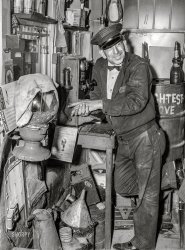
- Fishbowl: 1908
- ... Very prescient design.
Love it!! Re-posted to Michigan in Pictures with links to more historical information on Belle Isle ... Posted by Dave - 04/10/2023 - 4:16pm -
![Fishbowl: 1908 The Belle Isle Park Aquarium in Detroit circa 1908. Its cavernous spaces and glass viewports afforded aquatic life a fascinating peek at the bipedal terrestrial creatures known as homo sapiens. 8x10 inch glass negative, Detroit Publishing Company. View full size.
Hey, what's in that vase?Ewwwww...
Those spittoons just disappeared over the years. And leaving our local museums spit-free except for the occasional cobra or llama. Bet there were some great echo effects bouncing off all the tile work. As a wee bipedaling homo sapien I remember testing out such places with gleeful boy noises. That is one magnificent barrel arch beyond the equally grand dome ceiling.
A Sign of CivilizationI await the return of spittoons to all public buildings.
PixelatedIt's interesting how the brickwork resembles pixels in a digital photo.
[Or a TV. Which was my impression, too -- "These tiles are tiling!" - Dave]
In Swimming ColorThe aquarium today, in all its green glory.
The forward lookBrass expectoration appurtenances notwithstanding (say that fast five times), this photo has a distinct contemporary feel to it - the lighting, natural yet at the same time seeming to be carefully arranged, plus the composition. I can see it on slick paper in an upscale lifestyle-type magazine, advertising fashions, perfumes or other snazzy stuff. Come to think of it, the visual aesthetic, if not the architecture, reminds me of that of the Case Study homes photographs. The pixelation-like effect of the brickwork is also eerily arresting.
League of Extraordinary Museum-GoersWow, the first thing I thought was "steam-punk." Those brass railings and the radiator and the projecting stands for the aquariums are all very cool!
Gone, almostThe building is still there on Belle Isle, but the city closed the aquarium last year due to Detroit's disastrous financial situation. Sigh.
--Ray in Henderson, NV
The Shocking TruthI remember the electric eel that would swim around in its tank and periodically light up a neon sign.
Pewabic Tiles Another Detroit treasure with tiles made by Pewabic Pottery, which is still in business.
Really SciFiAfter the "Lady in the Lake," this image is the most striking I have ever seen on Shorpy (and that's saying something!) Thank you Dave!
Wow, wow, wow, wow, wowThis photo is really ... eerie. It just looks so different from modern times that I can hardly believe it ever happened.
And how in the world did they clean the tanks on those ornate stands jutting out into the middle? Is that an optical illusion, or does the round railing keep one from falling down to another story below?
Thank you for posting the modern photo showing the green tile. I never would have guessed the color. I hope Detroit does better this year, and I hope they can keep this place open in the future.
But what did they do with the fish?I visited the aquarium with my first grade class in the spring of 1957, the high point of the school year.
And it was foreign travel from Windsor Ontario. Back then, we only needed notes from our mothers to cross the border!
Life AquaticI've got relatives in Detroit of long standing, but I've never heard of this delight until now.
There are a few more present-day pictures (how dazzling that green tile is!) on the tour here:
http://www.belleisleaquarium.com/aquarium_tour.htm
Yes, thanks KwameThank you Kwame for closing our wonderful aquarium just so you could spend all the money on your criminal activity. What a shame. Recent pictures that I have seen show that the former aquarium is now full of crap and is being used for storage. Nice.
FramesI really like the frames surrounding the wall tanks, presenting the displayed sea-life like works of art. I wonder if the frames were painted gold or silver to look like gilding.
Fate of the fishThe fish were loaned out to various aquariums across the country. Come visit the aquarium again. Friends of Belle Isle Aquarium care for the koi that overwinter in the basement. They are usually there on Saturdays, late morning, caring for the fish. Check out their website, belleisleaquarium.com for more information or to get involved.
The original aquarium frames were constructed from cypress, a wood particularly resistant to damage from moisture, and were gilded. The frames were carved in an egg and dart motif to frame the exhibits as if they were canvases. The frames were removed during the 1955 renovation and replaced with stainless steel.
The lovely tiles are green glass. They were not made by Pewabic pottery ... a common misconception.
Eero SaarinenI too thought it was a modern building. Very prescient design.
Love it!!Re-posted to Michigan in Pictures with links to more historical information on Belle Isle Aquarium!
(The Gallery, Detroit Photos, DPC, Education, Schools)](https://www.shorpy.com/files/images/4a22191u.thumbnail.jpg)
- Commuters: 1907
- ... hear from Chuck that it still hasn't changed.
6 North Michigan At the time of this photo, the tower in the background was the ... Posted by Dave - 07/30/2012 - 10:07pm -
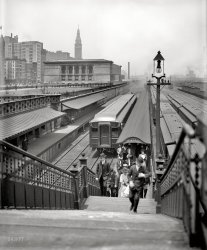
- Cadillac Square: 1902
- ... the experience encountered when traveling south out of Michigan in the dead of winter and you first experience the smell of the earth ... smoke is from those cheap cigars.
To be fair about Michigan Esteemed fellow Shorpy-ite FotoFantasist correctly mentions clean ... Posted by Dave - 02/13/2013 - 12:14pm -
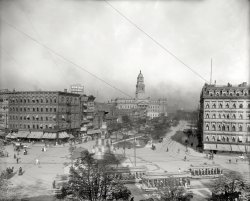
- Woodward Avenue: 1917
- Detroit, Michigan, circa 1917. "Looking up Woodward Avenue." Dry plate glass negative, ... Posted by Dave - 07/24/2012 - 9:50pm -
![Woodward Avenue: 1917 Detroit, Michigan, circa 1917. "Looking up Woodward Avenue." Dry plate glass negative, Detroit Publishing Company. View full size.
"Mellow as Moonlight"If I was a drinkin' man, I would be sippin' some a that Cascade whiskey.
Motor city, for sure!Not one single horse in view.
Temporal AcheMan, this is one of those Shorpy photos that really make me wish I had a time machine.
Not much leftAbout the only thing still remaining is the Soldiers' and Sailors' Monument, and even it has been moved about 300 feet from where it stood for 130 years.
An amazing photo.
Casting against TypeI see the film "Somewhere in Georgia" is playing, where Ty Cobb stars surprisingly as a small-town Georgia baseball player who signs with the Detroit Tigers.
Health InsuranceAlmost 100 years later, the country is in a major pique over health Insurance and the Detroit Creamery had the answer all along. This maybe the best urban photograph yet, it certainly is the busiest.
Notice the #2 streetcar?It's got one of those fancy-schmancy 'people scoopers' on it, like this:
https://www.shorpy.com/node/4468
HodgepodgeOne of the best urban pictures yet! Too much to take in at one sitting; The Opera House, that wonderful memorial, the traffic, those streetcars. I wonder what the tent was for in front of that fountain, just across from the Opera House.
FascinatingThere's so much to look at in this photo. I especially enjoy seeing people going about their daily lives, not posing for a camera.
The movie theater sign says "All Next Week, Somewhere in Georgia". According to IMDB.com "Somewhere in Georgia", starring Ty Cobb, was filmed in the winter of 1916 and released in June 1917. Is the 1915 date on the photo in error?
[Do we know what "circa" means? - Dave]
An Edison ElectricI notice that the Edison Electric is being driven by a woman. My grandmother (who lived in Detroit) said that the only car she ever drove was an Edison Electric. She was afraid of driving a gasoline-powered car.
[Women liked electrics because there were no gears to shift, and no clutch -- shifting and clutching on cars of that era required quite a bit of muscle. - Dave]
Cloudy crystal ballCover story in Time Magazine, October 5, 2009: "The Tragedy of Detroit: How a great city fell, and it it can rise again."
Speaking of moonlightFarewell, good moonlight towers. Twenty years gone by the time of this photo.
Is it a coincidence that Shorpy has hit upon another star of the silent screen? The theater beneath the Blackstone Cigar sign (far right)features Gladys Brockwell, who, like Kay Laurell (1890-1927), died in her thirties. Horrific 1929 car crash in California.
Merrill FountainThe Merrill Fountain in front of the Opera House still exists, too. Granted, it was moved about seven miles up the road to Palmer Park.
Before it was called Wootwart (Woodward)The definition of the "good old days" ...
Traffic LightsGreat image. Did traffic lights look different then, or did they not have them in Detroit?
[In 1917, traffic signals came on two legs. - Dave]
Re: An Edison ElectricLooks more like a Detroit Electric car than the very rare Edison.
The main reason the ladies like the electric car was no crank starting. Charles Kettering changed that a few years later with the electric starter motor if IC engines.
Notice the complete absenceof horse poop. And horses.
Stop sign doesn't apply...Surprised to see that pedestrains do not follow traffic signs as they crossed the streets. It seems that those signs were for trolleys and cars only. It anwered my question why my g-g-great uncle got killed by a trolley.
ProsperityWow! You can almost hear the hustle and bustle of prosperity in this amazing photograph -- the essence of early 20th century proud American urbanity. Go to Google Earth or some other mapping web site and visit the corner of Woodward and Fort today -- a dreary, faceless, lifeless desert of glassy highrises without a pedestrian in sight.
HeartbreakingWhen I go through Detroit now it is a vast third world, broken down, trashed city, with gangs and thugs peering from behind collapsed buildings. How in the name of all that is worthy could this magnificent American city come to what it is today? Almost makes me want to watch Glenn Beck.
Oh what a feelingI had to smirk a bit when I opened of the intersection on Google streets and the first thing I saw was a shiny Toyota.
FABULOUSThis image is go busy and wonderful. There is so much to notice. I wonder what the conversations were and so much more.
There is a tent in the middle of the square to the left of the statue. Why? What is the statue of?
All in WhiteI love the woman all in white crossing the street with her plaid skirted friend (near the front of the photo, just before the frontmost car). She looks so different than everyone else.
I bet the two women just walking into the frame below them are talking about her. She's showing ankle AND calf! I'm sure she'll be a flapper in a few years!
The girl in whiteI think that the girl in white is in fact a girl - probably a young teen accompanying her mother (the lady in the plaid skirt). Therefore she would be perfectly well dressed for her age. However that also means that she would be in the right demographic to become a flapper once the twenties (which would coincide with her twenties) rolled around.
Great picture - Lord I could look at it for hours!
That banner over the street"ENLIST NOW! YOUR COUNTRY NEEDS YOU"
And to your left...Seems even Detroit had its requisite "Seeing..." touring bus company. I count three "charabancs" in this photo, one across the street from Bond's with "WELLS" emblazoned on the back, and two in the centre-left crammed with mostly female tourists. Wonder what they were off to see next?
I'm loving the little insignificant human moments the photographer caught and immortalized: the man at the lower left trying to make something out on a bulletin board; the hefty many putting his arm around his companion's waist next to the memorial; three ladies converging outside the theater. Fantastic.
The building on the far leftis the 1896 Majestic Building, designed by the famous Chicago architect Daniel Burnham. Among other things, Burnham also designed the Flatiron Building in NYC, and oversaw the construction of the 1893 World's Columbian Exposition. The Majestic was Detroit's tallest building until 1909, when the Ford Building (also a Burnham creation) was completed. The Ford still stands today, as well as Burnham's other Detroit creations, the David Whitney Building and the Dime Building. Sadly the Majestic was torn down in 1962 to make way for the exponentially less-interesting 1001 Woodward Building.
“Make no little plans; they have no magic to stir men’s blood and probably themselves will not be realized. Make big plans; aim high in hope and work, remembering that a noble, logical diagram once recorded will not die, but long after we are gone be a living thing, asserting itself with ever-growing insistence. Remember that our sons and our grandsons are going to do things that would stagger us. Let your watchword be order and your beacon beauty.”
-Daniel H. Burnham
Sight Seeing in Detroit ca. 1917The Dietsche Sight Seeing Company was one of several companies that offered tours of Detroit back in this time period. Below is a photo of their advertisement offering their services to local companies who might want to entertain their out-of-town customers with a "Sight Seeing Trip around the city, Belle Isle, or Water Works Park."
Given the description of the street banner, this photo was probably taken sometime around June 5, 1917, which was the date on which all men between the ages of 21 and 31 were required to register for the draft.
Soldiers and Sailors MonumentStill nearby, but not as nicely maintained.
Very Nicely MaintainedThe Soldiers & Sailors monument is actually very well maintained. Notice how it's not all blackened with soot as in the old photo. When you view it up close you can also see where some very nice restoration has recently been done. Not everything in Detroit is a rotting hulk.
Still busyNot like this, but the ice skating rink at Campus Martius is already set up and would be approximately directly in front of the Detroit Opera House. Downtown Detroit is not the home of thugs or crime at all, really, but is sadly quiet when the businesses are closed. Many of the buildings are still here, and magnificent. Come visit before they tear them all down.
I'll be ordering a large print of this image! Thank you Shorpy.
Re. "Mellow as Moonlight"I saw this photo a few days ago, and, like GeezerNYC, I was quite struck by the Cascade Whiskey billboard. Now, I know that Geo. Dickel is still in business, and I was familiar with Dickel's Tennessee Sipppin' Whiskey and Old No. 8, but I had never heard of Cascade. It must have gone the way of the buggy whip and Lydia Pinkham, I thought.
But then today I stopped at the liquor store after work to pick up a bottle of wine, and GUESS WHAT THEY HAD?!?! shhhh...too loud. So, then
and I bought some. And do you guys know what? It's pretty goood. I';m drikning it right now. And I just wanna
True story I swear.
Hey! do you know what? I bought some oft hat Cacsade whiskey? Or is it whishky? Aanyway, I just wanna
You know what/ You guys are greatf. I just wanna
Hudson's Grows, and...Hudson's grew with Detroit, and perhaps inevitably, declined with Detroit.
Cascade HollowThe current Cascade Hollow Whiskey was created to deal with a shortage of the Dickel No. 8 and then just hung around. They didn't have enough whiskey of a certain age so they made a new brand and put their younger stuff in it so that the quality of the No. 8 wouldn't suffer. The Cascade Hollow has been discontinued, but it's still on the shelves in many places.
The name Cascade was replaced by the Dickel name after Prohibition and a number.
In order of price (& quality) the current Dickel offerings are:
(Cascade Hollow)
Dickel No. 8
Dickel No. 12
Dickel Barrel Select (which is one of the best whiskeys I've ever had. And I've had a lot.)
Anyway, Dickel is currently owned by the evil international spirits conglomorate Diageo, which also owns Guinness, Hennessey, Smirnoff, Johnny Walker, Tanqueray, Bushmills, Cpt. Morgan, Jose Cuervo, Crown Royal and many many more.
I can't relate to this picture at allThere is no one in this picture that looks like me or anyone else in my family and for that matter most of my friends...maybe that's how most of the people making comments about it want Detroit to look like.
Movie ID helpIn the background, there appears to be a movie showing called "The Spoilers", but Wikipedia says it came out in 1914, not 1917. Just below that it looks like "Barrymore (?) as Georgia" and to the left of that is "Ty". Anyone have some ideas as to which movies are being advertised?
[The movie is "Somewhere in Georgia," with Ty Cobb, released in 1917. - Dave]
Re: Re: An Edison ElectricMy great-great-grandfather Frank Montgomery Foster was selling Kissel Kars in Detroit. In 1913, he also had "one of the Detroit's finest garages at the corner of Gratiot Avenue and Grand Boulevard." It looks like the two cars in the bottom left of the photo (with the barrel fronts) may be Kissels, but I don't know enough about autos of the era to ID them.
KernsMy co-worker's last name is Kerns. I showed him this picture one day and eventually forwarded it to him. He then forwarded picture to his family and learned that his mother Americanized their Polish name around 1917 after seeing that building "Kern's Children's Clothes."
One of the best!The photo is insanely busy and the comments led me on a couple scavenger hunts online. Introduced to Gladys Brockwell, Daniel Burnham, Cascade, Dietsche company, etc. A very entertaining hour and a half on this one pic! Of course, being from Detroit makes it that much more interesting. Also, Heartbreaking, Detroit is a pheonix. You watch what she can do! The people have so much spirit. We love our city like a member of our family.
(The Gallery, Cars, Trucks, Buses, Detroit Photos, DPC, Streetcars)](https://www.shorpy.com/files/images/4a24908u.thumbnail.jpg)























